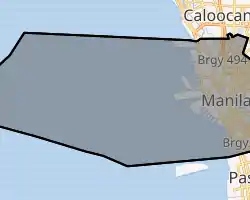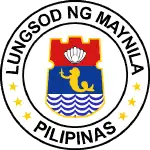Manila
Manila (Tagalog: ᜋᜈᜒᜎ) is the capital city of the Philippines. It is one of the largest cities in the Philippines. Manila is on the biggest island of the Philippines, Luzon. Manila is by a bay named Manila Bay. The metropolitan area, called Metro Manila, is much larger. It stretches across a thin strip of land (called an isthmus) to a lake called "Laguna de Bay". Manila has a population of 1.78 million people.
Wikimedia Commons has media related to Manila.
Manila
ᜋᜈᜒᜎ | |
|---|---|
Capital and highly urbanized city | |
| ᜎᜓᜅ᜔ᜐᜓᜇ᜔ᜅ᜔ᜋᜌ᜔ᜈᜒᜎ (City of Manila) | |
   | |
 Flag  Seal | |
| Nickname(s): Pearl of the Orient[1] | |
| Motto(s): Manila, God First | |
| Anthem: Awit ng Maynila English: Song of Manila | |
 Map of Metro Manila with Manila highlighted | |
OpenStreetMap  | |
| Country | |
| Region | National Capital Region (NCR) |
| Congressional District | 1st to 6th districts of Manila |
| Administrative District | 16 city districts |
| Established | 13th century or earlier |
| Sultanate of Brunei (Rajahnate of Maynila) | 1500s |
| Spanish Manila | June 24, 1571 |
| City Charter | July 31, 1901 |
| Highly Urbanized City | December 22, 1979 |
| Barangays | 896 |
| Government | |
| • Type | Sangguniang Panlungsod |
| • Mayor | Isko Moreno (Aksyon/Asenso Manileño) |
| • Vice Mayor | Honey Lacuna (Aksyon/Asenso Manileño) |
| • City Representatives | List |
| • City Council | Councilors |
| • Electorate | 1,133,042 voters (2022) |
| Area | |
| • City | 42.88 km2 (16.56 sq mi) |
| • Urban | 1,474.82 km2 (569.43 sq mi) |
| • Metro | 619.57 km2 (239.22 sq mi) |
| Elevation | 7.0 m (23.0 ft) |
| Population (2020 census)[5] | |
| • City | 1,846,513 |
| • Density | 41,515/km2 (107,520/sq mi) |
| • Urban | 22,710,000[6] |
| • Metro | 12,877,253 |
| • Metro density | 20,785/km2 (53,830/sq mi) |
| • Households | 486,293 |
| Demonym(s) | English: Manileño, Manilan; Spanish: manilense,[7] manileño(-a) Filipino: Manileño(-a), Manilenyo(-a), Taga-Maynila |
| Economy | |
| • Income class | special city income class |
| • Poverty incidence | 5.71% (2015)[8] |
| • HDI | 0.773[9] – high (2018) |
| • Revenue | ₱₱17,922,805,500.00 (2020) |
| • GDP | US $182.8 billion |
| • Assets | ₱74,464,757,574.00 (2020) |
| • Liabilities | ₱22,420,747,872.00 (2020) |
| • Expenditure | ₱17,874,675,033.00 (2020) |
| Utilities | |
| • Electricity | MERALCO |
| • Water | • Maynilad (Majority) • Manila Water (Santa Ana and San Andres) |
| Time zone | UTC+8 (PST) |
| ZIP code | +900 – 1-096 |
| PSGC | |
| IDD : area code | +63 (0)2 |
| Climate type | Tropical monsoon climate |
| Native languages | Tagalog |
| Currency | Philippine peso (₱) |
| Website | manila |

Flag of the City of Manila

Seal of the City of Manila

Manila and the metropolitan area
References
- "'Pearl of Orient' Stripped of Food; Manila, Before Pearl Harbor, Had Been Prosperous—Its Harbor One, of Best Focus for Two Attacks Osmeña Succeeded Quezon". New York Times. February 5, 1945. Retrieved March 3, 2014.
Manila, modernized and elevated to the status of a metropolis by American engineering skill, was before Pearl Harbor a city of 623,000 population, contained in an area of fourteen square miles.
- "Cities". Quezon City, Philippines: Department of the Interior and Local Government. Archived from the original on March 9, 2013. Retrieved November 30, 2012.
- "An Update on the Earthquake Hazards and Risk Assessment of Greater Metropolitan Manila Area" (PDF). Philippine Institute of Volcanology and Seismology. November 14, 2013. Archived from the original (PDF) on June 24, 2016. Retrieved May 16, 2016.
- "Enhancing Risk Analysis Capacities for Flood, Tropical Cyclone Severe Wind and Earthquake for the Greater Metro Manila Area Component 5 – Earthquake Risk Analysis" (PDF). Philippine Institute of Volcanology and Seismology and Geoscience Australia. Archived from the original (PDF) on August 6, 2016. Retrieved May 16, 2016.
- "Philippine Population Density (Based on the 2015 Census of Population)". Philippine Statistics Authority. Retrieved November 2, 2017.
- "Demographia World Urban Areas PDF (March 2013)" (PDF). Demographia. Retrieved November 24, 2013.
- This is the original Spanish, even used by José Rizal in El filibusterismo.
- "PSA releases the 2015 Municipal and City Level Poverty Estimates". Quezon City, Philippines. Retrieved 1 January 2020.
- Sub-national HDI. "Area Database – Global Data Lab". hdi.globaldatalab.org.
This article is issued from Wikipedia. The text is licensed under Creative Commons - Attribution - Sharealike. Additional terms may apply for the media files.